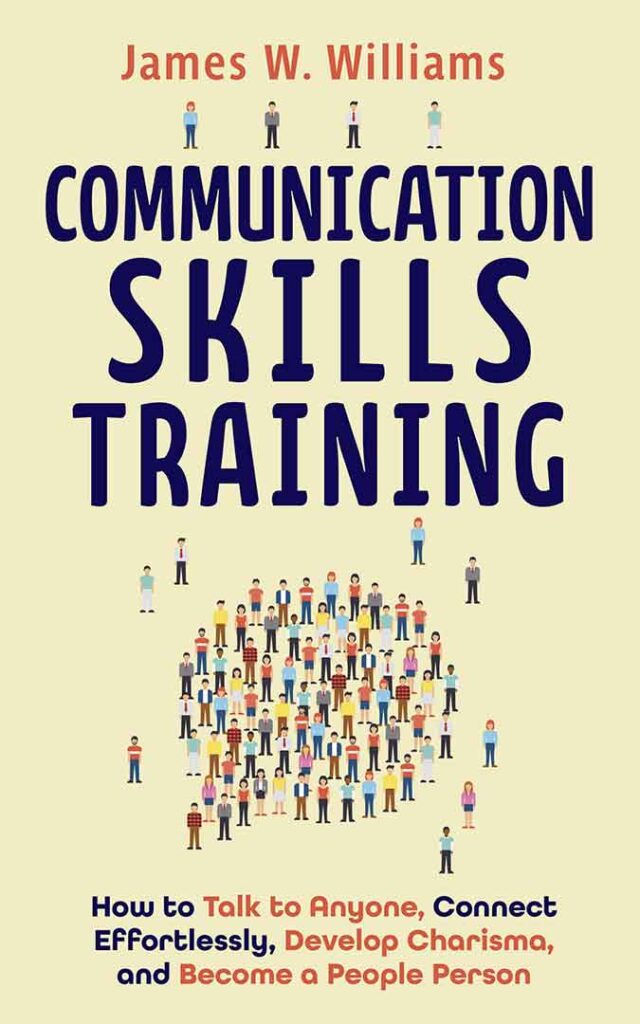Good communication is an integral part of all relationships – it plays a role in having a healthy partnership. No relationship is perfect. There will always be ups and downs, but there’s nothing a healthy and open communication style cannot solve. You’ll find 17 communication exercises for couples that will help you grow closer.
At TheArtofMastery.com, we provide best-selling self-improvement books to make you a better communicator, improve your relationships, increase self-esteem, understand human psychology, and more.
Take a look at our best-selling books here.
Why Communication Is Important in Any Relationship
When you don’t communicate, you are not sharing a part of yourself with your partner. People tend to hold onto their own thoughts and feelings for a variety of reasons.
- One of the reasons why two people in a relationship struggle with communicating what they feel is that they are afraid of rejection. They are anxious about saying or doing something that might upset their partner. While these are valid, not telling your partner about what you want and need won’t help the relationship to grow.
- Having good communication between partners will come in handy during misunderstandings and disagreements. You and your partner are likely to look at situations quite differently, which if not communicated well, might lead to resentment. The absence of good communication may lead couples to become upset with each other and they both don’t have any idea why or how it started.
- Having an open and positive communication among couples will help in clearing each other’s expectations in their relationship.
- When you and your partner are aware of your expectations, it would be difficult to dismiss those expectations because the two of you “discussed” them. Again, we go back to the main reason why communication is integral – it avoids misunderstandings among the two people in a relationship.
Benefits of Communication Exercises for Couples
Relationships can be tough sometimes. Building a “context” of what your partner is saying will significantly increase the closeness and emotional intimacy between the two of you. It also helps you become a good listener.
- Misunderstandings are easily dealt with.
Disagreements can be avoided if only the two of you are communicating with each other well.
Being able to easily talk with your partner helps in minimizing disagreements because assumptions will be avoided.
- Finding context helps minimize disconnections
Increasing your understanding of your spouse and how you convey what you want to say to each other are ingredients of good communication. If it does go awry, it will still be easier to reconnect because you have built a better “context” of each other.
- You are able to determine what your partner is actually saying.
Communication will be easier once you build a new context of each other. You can easily tell each other what is upsetting you.
With good communication, both of you will have a good grasp of how each other feels.
- There is no guessing game
Good communication ensures that misunderstandings and disagreements are minimized, if not eliminated. You know exactly what they mean. Thus, you are less likely to misinterpret what the other person is trying to say.
- Builds trust
When you are assured that both of you are being honest with one another because of the presence of good communication, disagreements are lessened.
- You build Intimacy and closeness.
Once trust is built in relationships, everything will follow. By being able to express your thoughts and feelings, you can build emotional closeness and intimacy.

Communication Exercises for Couples
Can you confidently say that in your relationship, you can easily figure things out? To help you and your spouse, here are helpful exercises you can try as a couple, targeting verbal, nonverbal, or written communication.
Communication Exercise #1. The “fireside chats”
During the time of U.S. President Franklin D. Roosevelt, he used informal radio broadcasts to talk to the American people. Listeners were said to create images of them sitting in front of a fireplace having a conversation with the president. That’s where “fireside chats” originated.
With this exercise, you’ll need to schedule a “fireside chat” with your partner at least once a week. This exercise will only take 15 to 30 minutes of your time.
Performing this exercise helps promote calmness. It also teaches you to use respectful words when discussing different issues like conversations about mothers-in-law.
Performing this exercise allows you to focus on each other rather than focusing on the disagreements.
Communication Exercise #2. The high and low
Verbal communication activities help you to freely express yourself, while your spouse adopts attentive listening skills. You should do this in the evening, like while having dinner or at bedtime. This activity will allow couples to check in with each other about how they spent their day.
You and your partner will take turns sharing the best part of your day, this is the “high” aspect. Additionally, the most disappointing aspects to be discussed will be the “low”.
As your partner shares about their day, you will use your listening skills just to convey understanding and empathy. When it’s your turn to speak, your partner will take the listener role.
Communication Exercise #3. “Eye can see you”
This technique is a nonverbal communication exercise. It focuses primarily on eye contact. You will be seated on separate chairs facing each other. Choose a quiet and relaxing area, with less distractions as much as possible.
Both of you should maintain eye contact for five minutes, without looking away. During this time, both of you should try to allow internal thoughts and feelings to surface and manifest.
By the end of this activity, you and your partner are encouraged to talk about what you’ve just experienced.
Each one of you should be given the opportunity to guess what the other was thinking in order to assess connection, whether the nonverbal messages came across.
Communication Exercise #4. “Hear me without words”
This activity will focus on both the verbal and non-verbal communication.
You will set a timer for 3 to 5 minutes. Each of you will be allowed to verbalize whatever you are thinking and feeling. The other person will not be permitted to interrupt while the other is talking.
During this time, as the other person is verbalizing, the other partner will use non-verbal techniques to express understanding, encouragement, and empathy.
After the timer goes off, you and your partner will process the experience by talking about feelings, ideas, and observations.
You will then switch roles for a chance to experience both skills.
Communication Exercise #5. Send a postcard
This one is intended to improve written communication. You will both have a blank postcard. You will write each other a message expressing your desire, a feeling, or disappointment, after which you will “exchange” postcards without uttering a word.
You will then both get a new blank postcard where you will write your response to each other’s messages.
Communication Exercise #6. Make the switch
When was the last time you and your partner had a conversation about how you feel? And when did you last listen to them rant about something? Do you talk about how each of your days went at the dinner table?
Agree on the time and day that you can perform this activity. For that particular period, you will switch roles in terms of communicating. You will try to think how your partner will respond to a situation. In turn, they will do the same.
For example, you are talking about what to eat for lunch. You will try to respond how your partner might respond, like they will suggest to order take-out or delivery. For their part, they will think that you’ll suggest to prepare homemade salad instead.
Do this activity with your partner every time you have the chance. Wouldn’t it be fun to know how your partner sees you in respect to how you respond to particular situations and scenarios?
Assertive Communication Exercises for Couples

Communication styles are divided into three categories:
• Passive Communication – happens when one individual doesn’t stand up for themselves. They become a “doormat” instead. Passive individuals often sacrifice their own needs and wants for the needs and wants of others.
• Aggressive Communication – resorts to intimidation to force the other person to give them what they ask for.
• Assertive Communication – occurs when one asserts their needs and wants, but they remain respectful. This style helps boost one’s self-esteem and increases respect.
Assertive communication brings something good in a relationship. Each of you will consider each other’s feelings and make adjustments out of mutual consent.
Communication Exercise #7. “I” statements
Avoid using “you”, “could”, and “should” in self-expression because it becomes a defensive reaction. It turns into an attack against the other person. Replace them with “I” statements.
You can tell your partner, “I understand____ because____. I’d like for you to___.
They will need to respond using the “I” statements too.
Your partner could say these as a response to your statement, “You sound ___ because ___ . I will and I ___, next time.”
With the above statements, your partner is being assertive regarding how they feel towards your actions. In turn, you are taking responsibility.
Communication Exercise #8. Revisit past arguments
You and your partner should identify three critical statements either of you used in previous arguments. You will work together to reformat each of these statements into how they could have been said without attack or criticism.
This should be done without ending up in another misunderstanding. There shouldn’t be any yelling. It is important to adapt the assertive ways mutually.
Communication Exercise #9. Stop name-calling
For this activity, each of you will list disrespectful and hurtful names you might have called each other. Once your lists are done, you will read your list separately. Each of you will be given an opportunity to tell each other what you felt towards your own self-confidence. The words may have been blurted out then because of anger and without any consideration of the feelings of one another.
Building Trust
Trust in each other is an important ingredient of any healthy relationship.
Communication Exercise #10. The copycat
This is a goal-oriented activity.
With the same set of building blocks, sit back to back with your partner. One of you will have to build a structure out of the building blocks you have. For instance, if you are tasked to build, you will need to give verbal directions to your partner for them to be able to build the same structure without seeing what you are building.
For this activity, your trust for one another will play a big role. Your partner will have to trust you that you will give clear and accurate instructions, just as you will trust them to build exactly how you instructed them to.
Communication Exercise #11. Through the “minefield”
For this activity, you will each create an obstacle course with different objects that will serve as “landmines”. Your trust with one another will again be tested in this activity.
You will have to guide your partner, who will be blindfolded, through the obstacle course, making sure they do not step on the “mines”. Your blindfolded partner will solely rely on how well you can give them accurate and precise directions so they won’t “die” when they step on the “mines”.
Communication Exercise #12. “Lend me a hand”
You and your partner will have to work together to achieve a common goal – and you will have an arm each that will be tied behind your backs.
Working together and good communication will get you through this challenge. Both of you will need to provide each other directions and actions that are concise and precise so you can both use each of your free hands to perform the tasks to be given. Any goal can be targeted, like tying a shoe, or buttoning a shirt, or clasping a necklace.
If you can both accurately communicate what to do, where to go, or how to do things, you will succeed with the “challenge”.
If you want to learn more about improving your communication skills, take a look at our best selling book Communication Skills Training.
Communication Exercises for Couples Who Are Soon to Be Married
With the idea that divorce can be quite expensive, most couples today seek premarital counseling to make sure that they are ready to take their relationship to the next level.
Engaged couples should also be performing communication exercises to help strengthen their relationships in the hopes of not becoming another statistic.
These communication exercises can be incorporated into the premarital counselling sessions, ideally with a mental health professional, however, the couples themselves can perform the exercises if they choose to.
The following exercises will attempt to make each of you become more aware of your communication styles as individuals. Also, the following activities will further increase your connection with one another, resulting to reinforcing trust in the relationship.
Communication Exercise #13. Reflection
This “reflection” exercise will help you and your partner improve on your verbal communication skills, as well as your listening skills.
One of you will tell a detailed story for about five minutes, after which, the other will give a reflection on what their partner just narrated. The person being asked to reflect on what they heard will have to rely on their active listening skills to be able to relay accurately what they just heard from their partner’s story.
On the other hand, the partner who was asked to narrate a story will dig deep into their verbal communication skills to make sure that their words will resonate, and their partner clearly understood what they’ve just heard.
Communication Exercise #14. Looking ahead
For this activity, you and your partner will be able to identify and accurately communicate your future goals and desires. You can discuss short-term and long-term goals. Doing so allows you to understand each other’s needs.
Encourage each other to create a wish list where you can share your dreams, future plans, desires, etc.
The purpose of this activity is to let each individual know how they can help each other achieve their goals. This is the time to be more open with your partner if you are not on this level of the relationship yet.
Communication Exercise for Couples #15. “Music and lyrics”
With this activity, you and your partner will express yourself via music. Both of you will choose three songs each – songs that you can relate to. You will then share the lyrics of each song with each other.
A lot of people express themselves more effectively with the songs they like. This activity allows couples to have a conversation about why they chose a particular song, what this song means to them, and how this song makes them feel.
It is also an exercise that will bring you and your partner closer to one another. You get to see each other’s vulnerable side through the music you chose.
Communication Exercise for Couples #16. Q&A
Do you know each other’s favorite dish or favorite vacation destination? This is an activity where you get to know each other more through your likes and dislikes.
You will prepare a set of questions about each other’s likes and dislikes. You will then exchange your lists. You will take turns in answering the questions on the list. This is a fun and healthy way to find out more about each other, especially if you intend to get married soon.
Communication Exercise for Couples #17. The “name game”
Each of you will choose a compliment or a positive quality to describe each other using each of the letters of each other’s names. You will both list down those positive words and later on read out loud. This activity intends to bring couples closer to one another and reinforce the positive things they found in each other.
This is a time to rediscover each other, especially if you have been together for a long time.

The Role of Communication Exercises for Couples
- For one, good communication is the basic foundation of a healthy and loving relationship.
- If the interaction between couples are clear, then the romantic cycle of actions is smoother.
- These communication exercises can actually improve the interaction pattern of people in romantic relationships. Also, it may help repair the damages brought about by toxic communication.
- The exercises help address whatever misunderstanding you have that both of you have been trying to avoid talking about. It allows the two of you to open up with each other.
- It helps bring couples closer.
- The above exercises will help improve both the verbal and non-verbal communication between couples.
Fixing the Hurdles
For most couples, they only find out that there are issues in their relationships when they begin doing these exercises. All the while, they thought everything was good between them – until now. Here are a few things to do to fix these issues.
If your partner doesn’t want to do these exercises
Some couples may have this problem. If your partner objects to doing this, you have two options:
• Let them know about the advantages of these exercises
• Or you can just skip their part – one way to improve communication in relationships is to bring a good change. You can practice most of these on your own.
“Why should we do these, we don’t have issues?”
These exercises are not just for couples who are having problems. These are designed for all kinds of couples, whether they are in good terms or not. These exercises might be able to help in solving issues in a troubled relationship.
Also, it helps improve the relationship of “healthy” couples. It brings you closer.
How often should you do these communication exercises for couples?
Ideally, couples should perform these exercises one or twice a week. At first, it would feel like it’s a task they need to do, but eventually, it can become a healthy habit that they could look forward to doing together.
Bottom Line
Good communication is one ingredient to having a strong and loving relationship. You cannot be in a relationship with another person without trust and understanding, and one of the ways to achieve that is for couples to be able to say and do things openly.
If you are looking for additional help to keep a healthy and open communication between you and your partner, our best selling book Communication Skills Training is a great resource.

